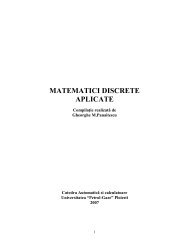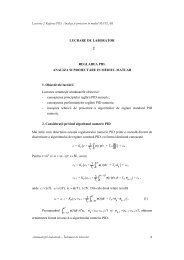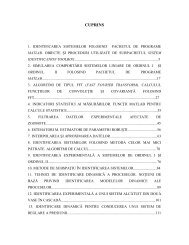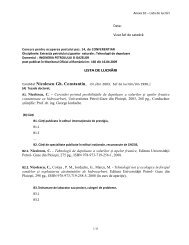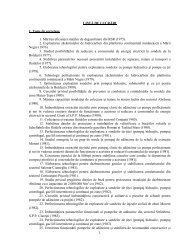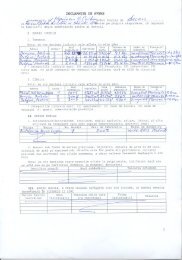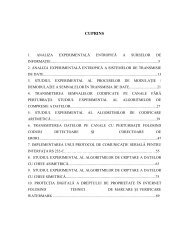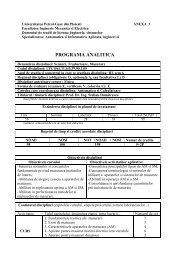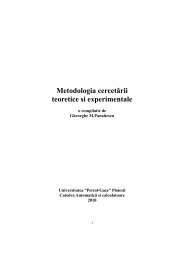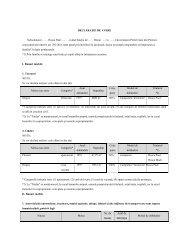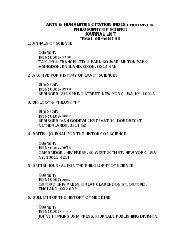Note de curs - Departamentul Automatica, Calculatoare si ...
Note de curs - Departamentul Automatica, Calculatoare si ...
Note de curs - Departamentul Automatica, Calculatoare si ...
Create successful ePaper yourself
Turn your PDF publications into a flip-book with our unique Google optimized e-Paper software.
N 2<br />
N<br />
x 1,2<br />
x 4<br />
2,4<br />
x 4,6<br />
N x 1 2,3<br />
x 2,5<br />
x 4,5<br />
x 1,3<br />
x 3,5<br />
x 5,6<br />
N 3<br />
N 5<br />
N 6<br />
O listǎ cu toate cǎile <strong>de</strong> la N 1 la N 6 :<br />
P 1 = {x 1,3 , x 3,5 , x 5,6 } P 8 = {x 1,2 , x 2,3 , x 3,5 , x 5,6 }<br />
P 2 = {x 1,2 , x 2,5 , x 5,6 } P 9 = {x 1,2 , x 2,4 , x 4,5 , x 5,6 }<br />
P 3 = {x 1,2 , x 2,4 , x 4,6 } P 10 = {x 1,3 , x 2,3 , x 2,4 , x 4,5 , x 5,6 }<br />
P 4 = {x 1,3 , x 3,5 , x 4,5 , x 4,6 } P 11 = {x 1,3 , x 2,3 , x 2,5 , x 4,5 , x 4,6 }<br />
P 5 = {x 1,3 , x 2,3 , x 2,4 , x 4,6 } P 12 = {x 1,3 , x 3,5 , x 2,5 , x 2,4 , x 4,6 }<br />
P 6 = {x 1,3 , x 2,3 , x 2,5 , x 5,6 } P 13 = {x 1,3 , x 2,3 , x 3,5 , x 4,5 , x 4,6 }<br />
P 7 = {x 1,2 , x 2,5 , x 4,5 , x 4,6 }<br />
Cǎile, se observǎ, sunt ordonate <strong>de</strong> la cea mai scurtǎ la cea mai lungǎ.<br />
Pentru a calcula alti termeni din sumǎ, trebuie avutǎ în ve<strong>de</strong>re intersectia mai<br />
multor multimi conditionate.<br />
P 1 = {x 1,3 , x 3,5 , x 5,6 }<br />
P 2 = {x 1,2 , x 2,5 , x 5,6 }<br />
P 3 = {x 1,2 , x 2,4 , x 4,6 }<br />
P 4 = {x 1,3 , x 3,5 , x 4,5 , x 4,6 }<br />
Pentru a calcula termenul al patrulea – expre<strong>si</strong>a lui P 4 – multimile conditionate<br />
sunt:<br />
S 1/4 = {x 5,6 }; S 2/4 = {x 1,2 , x 2,5 , x 5,6 }; S 3/4 = {x 1,2 , x 2,4 }<br />
S 1/4 este inclus în S 2/3 ; dacǎ S 1/4 este cu <strong>de</strong>fecte, atunci <strong>si</strong> S 2/4 este cu <strong>de</strong>fecte. S 2/4<br />
poate fi ignorat în acest caz.<br />
Al patrulea termen din ecuatia fiabilitǎtii este<br />
p 1,3 p 3,5 p 4,5 p 4,6 (1 – p 5,6 )(1 – p 1,2 p 2,4 )<br />
Calculul termenului al treilea conduce la<br />
S 1/3 = {x 1,3 , x 3,5 , x 5,6 }<br />
S 2/3 = {x 2,5 , x 5,6 }<br />
Cele douǎ multimi conditionate nu sunt disjuncte.<br />
Evenimentul care constǎ în <strong>de</strong>fectarea <strong>si</strong>multanǎ a multimilor <strong>de</strong> arce S 1/3 <strong>si</strong> S 2/3<br />
trebuie sǎ fie împǎrtit în evenimente disjuncte:<br />
(I) x 5,6 cu <strong>de</strong>fecte<br />
(II) x 5,6 este operational <strong>si</strong> atât x 1,3 cât <strong>si</strong> x 2,5 sunt <strong>de</strong>fecte<br />
(III) atât x 1,3 cât <strong>si</strong> x 5,6 sunt în functiune <strong>si</strong> atât x 2,5 cât <strong>si</strong> x 3,5 sunt <strong>de</strong>fecte.<br />
Pentru termenul al treilea rezultǎ expre<strong>si</strong>a<br />
p 1,2 p 2,4 p 4,6 (q 5,6 + p 5,6 q 1,3 q 2,5 + p 5,6 p 1,3 q 2,5 q 3,5 )<br />
107



